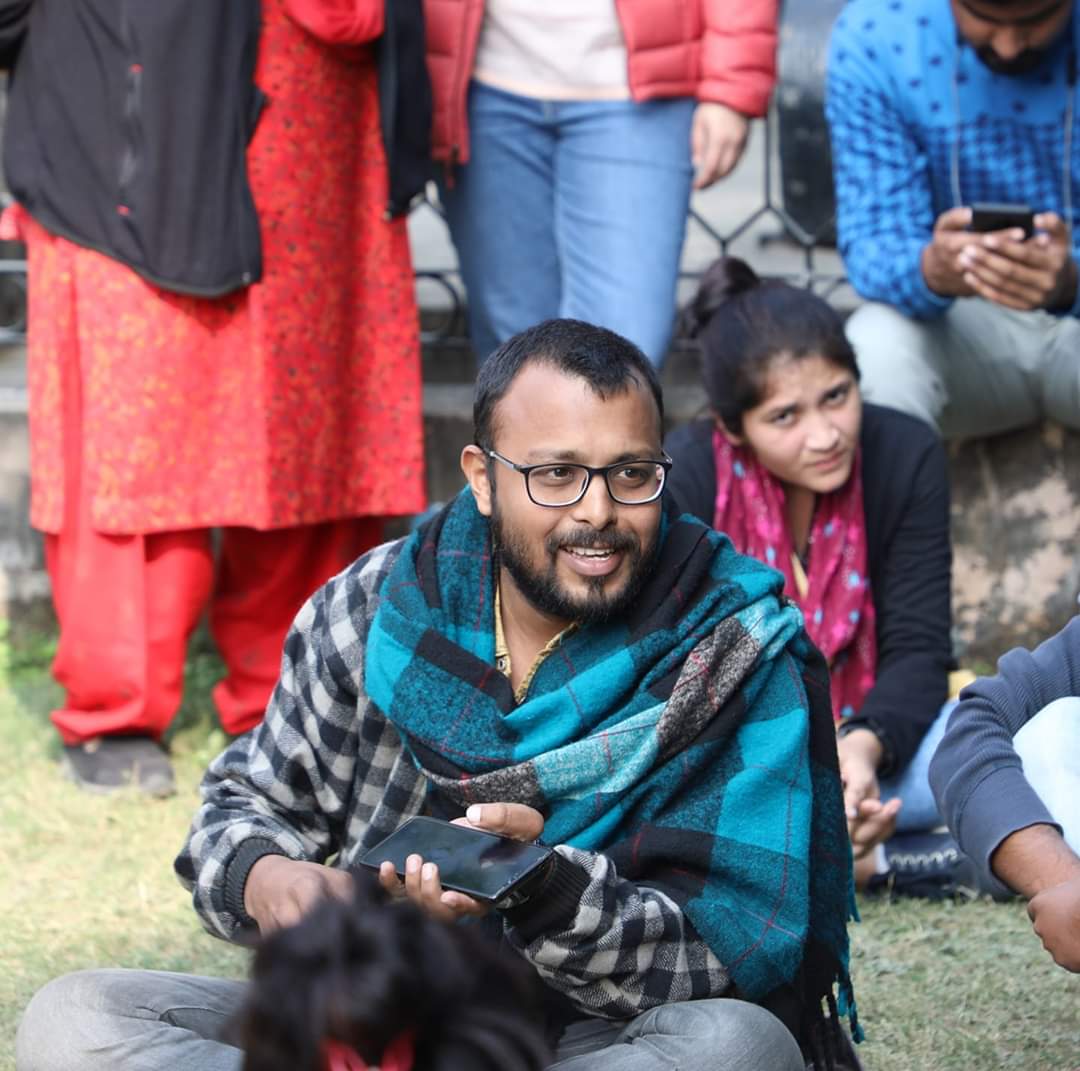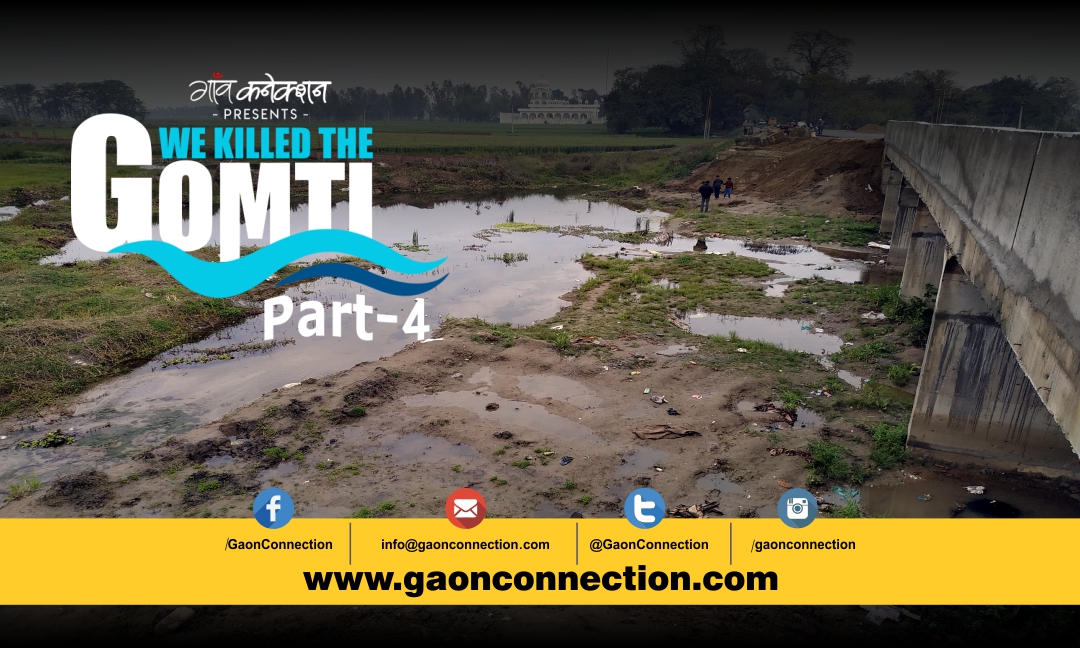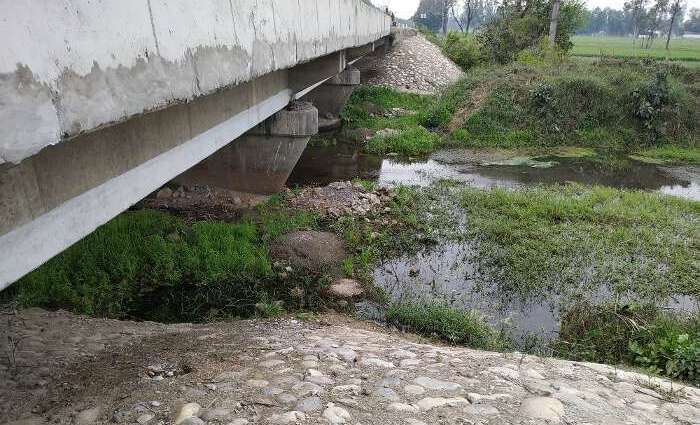“Many farmers believe that there is an unending supply of groundwater”
Satha dhaan – a variety of rice which farmers sow for their petty gains overlooking the fact that it consumes 10 times more water – is a proof that we are to be blamed for the demise of the Gomti


Ranvijay Singh & Daya Sagar
The Gomti River, which flows through eight districts in Uttar Pradesh, is dying a slow but certain death. We are killing it at its every twist and turn for our petty gains. In order to find out the extent of damage done, Gaon Connection’s team reached its origin at Madhav Tanda in Pilibhit, Uttar Pradesh, and undertook a four-day, 425-km-long bike expedition along its route to understand various issues plaguing the river.
Satha dhaan – a variety of rice which farmers sow for their petty gains overlooking the fact that it consumes 10 times more water than the regular crop – is a proof that we are to be blamed for the demise of the Gomti – a river that’s considered to be the second most important river in India after the Ganga.
“Many farmers are under the impression that there is an unending supply of groundwater and they are shamelessly ‘mining’ water for satha dhaan. If this continues, this region would turn into another Bundelkhand,” said Manjit Singh, 45, a resident of Panchkheda in Pilibhit district, which is around 250 kms from Uttar Pradesh’s capital Lucknow. “The river used to be wide when I was a kid. Now, it resembles a stream. Satha dhaan farming is to be blamed for this,” he added.
What is satha dhaan?
So, how is satha dhaan responsible for the demise of the Gomti? We met Dr SS Dhaka, an agricultural scientist, who works at Krishi Vigyan Kendra, Pilibhit. “There are two-three names for satha dhaan. Some farmers call it garmi wala dhaan, some call it chaini dhaan (Chinese) and the rest call it satha dhaan because it ripens in 60 days. There are two varieties of satha dhaan – long duration and short duration. The long duration one is sowed between February and March and the short duration one in April. Satha dhaan requires a lot of water. The main season of this crop is kharif. The season lasts from June to October, hence not much water is required. But, when satha dhaan is sown in February-March, it’s too dry and hence it consumes a lot of water,” he said.
He added: “The farmers are consuming groundwater for satha dhaan. The major issue is that the groundwater is not getting replenished because we have been having bad monsoon years. The water level is thus dwindling.”
Equating this with the dying Gomti river, VK Joshi, ex-director of Geological Survey of India, said: “Rivers like the Ganga and the Yamuna keep getting water because of constantly melting ice, but the Gomti is completely dependent on groundwater. There are many lakes close to Madhav Tanda, from where the river originates. They serve as a source for the river. Hence, the dwindling groundwater level has a direct impact on the river.”
“If we keep sowing satha dhaan, it will have a detrimental effect on the river. Satha dhaan is a hit in Pilibhit. Most of the farmers have debts to pay so they sow satha dhaan as an additional crop in summers. They want to make quick money, but they are not realising that in the process they are ruining ecological balance,” said Manjeet Singh, a resident of Panchkheda village, Pilibhit.
He added: “The groundwater is depleting fast. In the 90s, the water was available at 3-4 feet, but now one has to dig 14-15 feet deeper. Earlier, farmers would get water in their borewells at 15 feet, but now they have to go deeper than 25 feet. Sowing satha dhaan should be made a criminal offence.”

It’s banned in Punjab. In Uttar Pradesh, it’s widely sown in Pilibhit, Shahjahanpur, Rampur and Lakhimpur. “In 2016, the Shahjahanpur DM had banned satha dhaan. After this, I personally wrote a letter to the chief minister and the prime minister. I also filed a petition with the National Green Tribunal (NGT). But no one did anything about it,” said Manjeet Singh.
Just like him, Pushpajeet Singh too advocates a ban on satha dhaan. “Satha dhaan farming should be made illegal. It’s harming our environment. When we filed a petition in the NGT, people thought we were against the idea of satha dhaan, which was not the case. We were requesting them not to sow this during summers so that we don’t end up using groundwater,” he said.
Manjeet Singh added: “It’s not feasible to ban this as it’s a cash cow for the farmers. They are not even bothered that they are damaging the environment and killing the river. It’s a nexus. Because of satha dhaan, there are rice mills and pesticides chains in Pilibhit. Farmers are benefitting from all this. So, no one is bothered about the long-term impact.”
He added: “The river kept on shrinking and people started encroaching upon the land. The situation is so bad that recently during the recent land consolidation at Lohkai village, Pilibhit, the river was a part of the consolidation process. This is proof enough that we have killed the river. A few days back a team had arrived from Lucknow to study the river. They could not find it. This is how bad it is.”
There are five water bodies around Gomat Taal, the point of origin of the river. All have dried up hence the river is not getting enough groundwater. When we reached Gomat Taal, we saw that a solar pump was installed there. An attempt is being made to draw water from the ground and fill up those water bodies.
We met Dhaniram Kashyap, the ex village head of Madhav Tanda here. He said: “When Gomat Taal dried up, they installed this solar pump. They are trying to fill up the river’s source using this. This is what they are doing at Naimish Tirth and Sitapur where the source – Chakratirth – has dried up. The authorities have built a tank here through which they are filling up the source.”

Satpal Singh, who is associated with the ‘Gomti Seva Samaj’, said: “Last year, in May-June, the river was completely dry. I am just 30, but those who are in their 60s or 70s, even they had not witnessed something like this. It was completely dry until it started raining. It wasn’t flowing at Lakhimpur Khiri’s Junglinath, Purainaghat and many other spots. This was a first. So, imagine how bad the situation is. It’s alarming because we are not even getting sufficient rain from past many years.”
According to a report by the Ministry of Earth Sciences and the Meteorological Department – State Level Climate Change Trend in India – Uttar Pradesh is the only state in India which has seen less rain each year between 1951 and 2010.
Talking about the ‘tube well trend’ prevalent in Pilibhit, VK Joshi, ex-director of Geological Survey of India, said: “Farmers must understand that if the river vanishes, they will have to pack up and go away. The rate at which they are digging tube wells is shocking. The water level is like a bank account. Monsoon replenishes it. If you don’t deposit money in your account and if you keep withdrawing cash from the ATM, you would be served a notice. Nature is giving us signals, but we are ignoring them.”
He added: “The basic rule is that if you have dug a tube well, you are not supposed to dig another one in the 1,000 metres radius, but no one follows this rule. In fact, now we are digging deeper tube wells and ‘mining’ groundwater. It was fine a few years back because those were good monsoon years. But now that’s not the case. We haven’t had a good monsoon year in recent times and groundwater is not getting replenished and that is alarming.”
So, what’s the solution?
Environmental scientist Dr SS Dhaka, said: “We have to make the farmers aware. We will have to run various campaigns. We will have to discourage them from growing satha dhaan. We will have to make it a punishable offense. Farmers have many options. They can sow pulses, for instance.”
Satpal Singh added: “We should encourage afforestation around the river. This would help in replenishing the groundwater level. This way encroachment would stop too. We have to make a collective effort. It’s not too late.”
(This story is Part 4 of the five-story series ‘We killed the Gomti’)
Read Part One here
Read Part Two here
Read Part Three here

